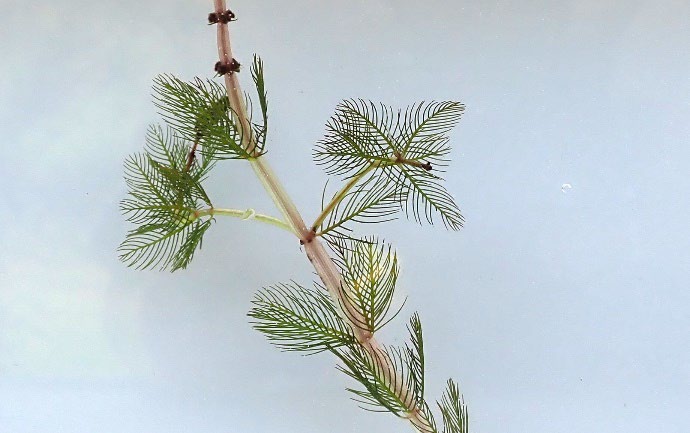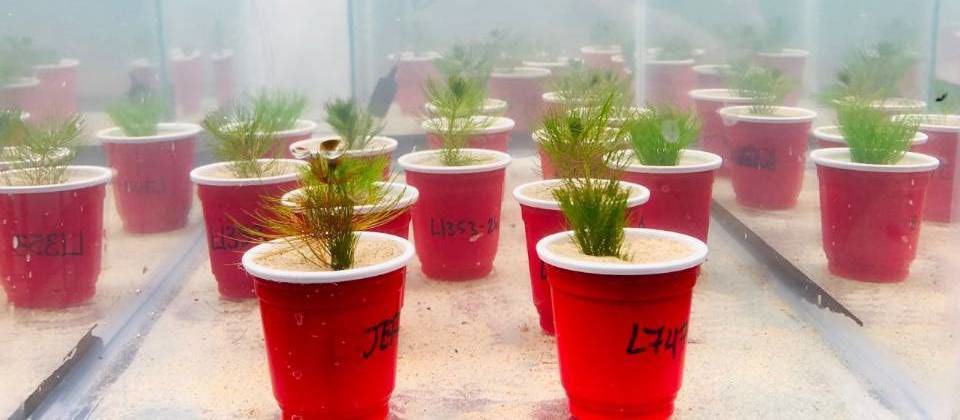
Identifying and managing invasive Eurasian and hybrid watermilfoils in Michigan lakes: A response to differential sensitivity to herbicides
DOWNLOADDecember 19, 2022 - Jo Latimore and Erick Elgin, Michigan State University Extension; James McNair and Syndell Parks, Grand Valley State University; and Ryan Thum, Montana State University
Summary
We genetically analyzed hybrid watermilfoil collected from lakes across Michigan and tested the hybrid plants’ susceptibility to a common herbicide, fluridone. We made two important determinations. First, there are many different genetic strains of hybrid watermilfoil in Michigan lakes. Second, these strains respond differently to fluridone, and some are highly resistant to it. Therefore, knowledge of what strain(s) of watermilfoil are present in a lake is very important when developing a management plan that includes control with herbicides.
Background

Eurasian watermilfoil (Myriophyllum spicatum) has been a problematic invasive weed in Michigan lakes for decades. Once introduced, it can rapidly grow and create dense stands that impede recreation and negatively impact lake life. Management approaches for Eurasian watermilfoil include herbicide application, biological control, and physical removal. Recently, lake managers and scientists observed that traditionally effective herbicides were failing to control invasive watermilfoil in some lakes (Berger et al. 2012, Chorak et al. 2020, Thum et al. 2012). Genetic analysis of plants from these lakes revealed that Eurasian watermilfoil had begun crossing with native northern watermilfoil (Myriophyllum sibiricum), leading to concern that hybrid plants may be herbicide resistant (Moody and Les 2002).
Today, aquatic plant managers increasingly recognize that Eurasian watermilfoil (including hybrids with native northern watermilfoil) is genetically diverse, and that strains can differ in their growth, spread, impacts, and herbicide response. A practical challenge for Eurasian watermilfoil management is developing efficient and effective methods to predict how a specific watermilfoil population will respond to a proposed control tactic (e.g., a specific herbicide) before implementing management.
Because management of invasive Eurasian and hybrid watermilfoil is a widespread need in Michigan lakes, we initiated a project to investigate the distribution of hybrid strains of watermilfoil across the state, and to determine the sensitivity of these strains to the common herbicide, fluridone.
Approach and findings
We engaged professional lake managers and volunteers from the Michigan Clean Water Corps (MiCorps) Cooperative Lakes Monitoring Program to collect samples of Eurasian watermilfoil from lakes across Michigan for genetic analysis. Participants were provided kits with supplies for preserving dried tips of watermilfoil plants, data forms for recording detailed location information for each sample, and instructions for shipping them to the laboratory. A similar sampling effort took place in Minnesota, with over 70 lakes sampled in each state.

We genetically analyzed the samples to determine which strain(s) occurred in each lake. The analysis revealed that many different genetic strains of hybrid watermilfoil exist, with some being rather rare while others being quite widespread. While most lakes appeared to only contain a single strain of hybrid watermilfoil, some lakes contained multiple strains (Thum et al., 2020). We also tested the response of selected strains to a common herbicide, fluridone, at a concentration known to be effective at killing Eurasian watermilfoil (6 parts per billion). When we compared the growth of plants treated with fluridone to untreated plants in the laboratory, we found that some hybrid strains were sensitive, and others were not (Chorak and Thum 2020).
Recommendations
Monitor your lake regularly for possible aquatic invasive plants. Early detection of invasive species when invasions are small in scale allows for more choices in control options (below). Once invasions become dense or cover a large area, control may become cost-prohibitive – especially in the case of physical and biological control approaches.
Identify aquatic plant species carefully. Michigan has many native watermilfoil species that typically do not cause a nuisance and are a beneficial part of the natural plant community in lakes. If you identify Eurasian watermilfoil and are considering herbicide treatment for control, we recommend genetic analysis to determine whether the population is purely Eurasian watermilfoil or a hybrid. Hybrids cannot be identified by physical characteristics alone. Because we know that herbicide resistance can occur in hybrid watermilfoils, you should determine what strain you are trying to control and gather the latest information on herbicide response for that strain before launching a control program. Our herbicide response data are public, and we encourage lake managers to share their experiences with various other strains with one another and their clients.
With this information in hand, develop a management plan. Your plan should include clear goals and objectives and a plan for monitoring and evaluating progress. Your plan should be developed in consultation with community members and stakeholder groups and may require involvement of permitting agencies and professional lake managers. Many lake management actions require permit(s). You will need to consider the resources available for investing in management and have a plan for adjusting your actions if the situation changes or your goals are not being met.
Management options for invasive watermilfoil in lakes include:
- Vigilance without active control: The population is monitored annually, with the possibility of action if it grows to nuisance levels.
- Physical control
- Hand pulling, including diver-assisted suction harvesting (DASH)
- Smothering (benthic barriers)
- Cutting/mechanical harvesting is not recommended because of the risk of spread by fragments.
- Biological control, such as application of herbivorous insects like the milfoil weevil (Euhrychiopsis lecontei)
- Chemical control: application of herbicide(s) approved for watermilfoil control; try to select an herbicide known to be effective against your strain of watermilfoil and avoid an herbicide if there are strain-specific data indicating resistance to that herbicide.
Next steps
Now that we have confirmed that there is genetic variability in hybrid watermilfoil populations and that certain genetic strains are less sensitive to the common herbicide, fluridone, we have two goals. In the near term, we plan to develop a freely accessible catalog of prioritized strains that provides distribution and herbicide response data from our investigations. This resource will help lake managers decide on the best management approach for the watermilfoil strain(s) in their lakes. We will prioritize herbicide response studies in the laboratory on strains that are particularly widespread or that are not responding to herbicide treatments in the field.
Our long-term research goal is to identify the genes involved in herbicide response to develop specific genetic assays to predict herbicide response. We are interested in identifying these genes because then we could develop a simple genetic test to predict herbicide response. That test would eliminate the need for time-consuming and complex herbicide response trials for specific watermilfoil strains, which require growing plants in the laboratory with herbicide exposure. A similar effort has been successful with hydrilla, another invasive aquatic plant. Researchers have discovered the genes in hydrilla that are responsible for its variable fluridone resistance, so now we can quickly and easily check the DNA in hydrilla from a particular lake to see if it is likely to be resistant to fluridone (Michel et al. 2004, Benoit and Les 2013). This type of process is common for weed management in terrestrial agriculture.
In the future, we may expand our work to include other herbicides. We currently focus on fluridone because it is widely used and applied at the whole-lake level, so plants across the lake are exposed to the same concentration of herbicide, making it easier to study. We are also interested in hybrid watermilfoil response to other common herbicides, such as 2,4-D, triclopyr, and ProcellaCOR. We will adjust our priorities if we find evidence in the field of variable response to another herbicide.
Contact
For further information on Eurasian and hybrid watermilfoil control in Michigan, contact the Michigan Department of Environment, Great Lakes, and Energy (EGLE) Aquatic Nuisance Control Program: http://www.michigan.gov/anc.
For genetic analysis of Eurasian or hybrid watermilfoils in your lake, contact Dr. Ryan Thum: https://www.montana.edu/thumlab/Genetic-Identifications/index.html.
References
Benoit LK and DH Les. 2013. Rapid identification and molecular characterization of phytoene desaturase mutations in fluridone-resistant hydrilla (Hydrilla verticillata). Weed Science 61(1): 32-40. DOI: 10.1614/WS-D-12-00018.1
Berger, ST, MD Netherland, and GE Macdonald. 2012. Evaluating fluridone sensitivity of multiple hybrid and Eurasian watermilfoil accessions under mesocosm conditions. Journal of Aquatic Plant Management 50: 135-144.
Chorak, GM and RA Thum. 2020. Identification of resistant clones of Eurasian (Myriophyllum spicatum) and hybrid (Myriophyllum spicatum x Myriophyllum sibiricum) watermilfoil to an operational rate of fluridone. Invasive Plant Science and Management 13(4): 247-251. DOI: 10.1017/inp.2020.34
Michel AR, RS Arias, BE Scheffler, SO Duke, MD Netherland, and FE Dayan. 2004. Somatic mutation-mediated evolution of herbicide resistance in the nonindigenous invasive plant hydrilla (Hydrilla verticillata). Molecular Ecology 13: 3229–3237. DOI: 10.1111/j.1365-294X.2004.02280.xC
Moody, ML and DH Les. 2002. Evidence of hybridity in invasive watermilfoil (Myriophyllum) populations. Proceedings of the National Academy of Sciences 99(23): 14867-14871. DOI: 10.1073/pnas.172391499
Thum, RA, MA Heilman, PJ Hausler, LE Huberty, P Tyning, DJ Wcisel, MP Zuellig, ST Berger, LM Glomski, and MD Netherland. 2012. Field and laboratory documentation of reduced fluridone sensitivity of a hybrid watermilfoil biotype (Myriophyllum spicatum x Myriophyllum sibiricum). Journal of Aquatic Plant Management 50: 141-146.
Thum, RA, GM Chorak, RM Newman, JA Eltawely, J Latimore, E Elgin, and S Parks. 2020. Genetic diversity and differentiation in populations of invasive Eurasian (Myriophyllum spicatum) and hybrid (Myriophyllum spicatum x Myriophyllum sibiricum) watermilfoil. Invasive Plant Science and Management 13:59-67. DOI: 10.1017/inp.2020.12
Acknowledgments
This project would not have been possible without the efforts of volunteers with the Michigan Clean Water Corps (MiCorps) Cooperative Lakes Monitoring Program, as well as the natural resource professionals who helped in the field, including Mark Heilman, Paul Hausler, Pam Tyning, Rick Buteyn, Chris Riley, and Eric Fieldseth. We thank our parallel project collaborators at the University of Minnesota: Ray Newman, Meg Duhr, and Jasmine Eltawely. Laboratory assistance was provided by many Montana State University students and research associates: Greg Chorak, Jeff Pashnick, Emma Rice, Hannah Hoff, Katie Gannon, Leah Simantel, Anna French, and Ashley Wolfe. This project was financially supported by the Michigan Invasive Species Grant Program and Minnesota Environmental and Natural Resources Trust Fund.



 Print
Print Email
Email


